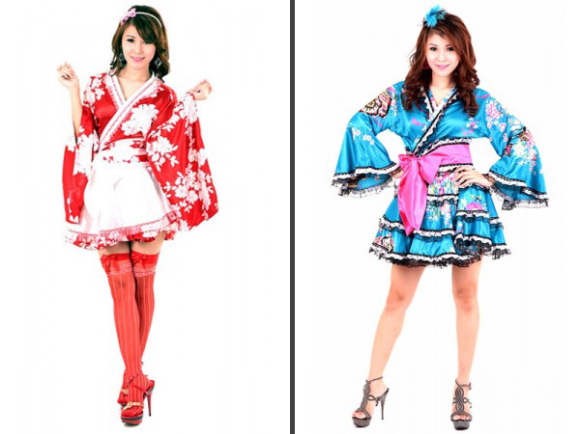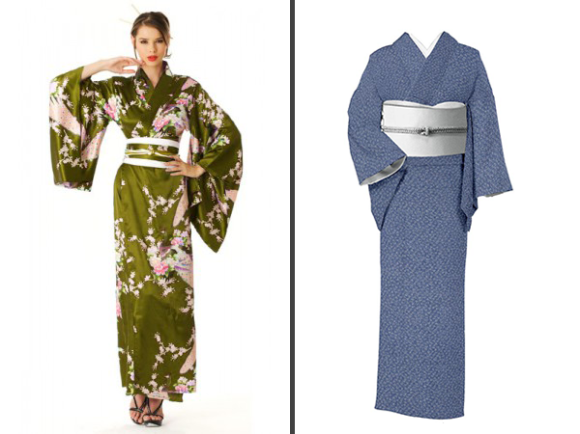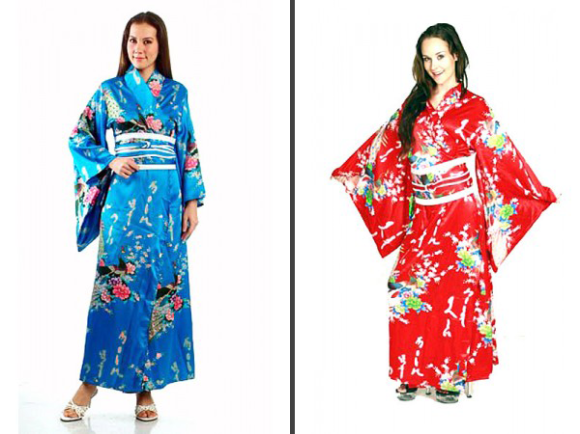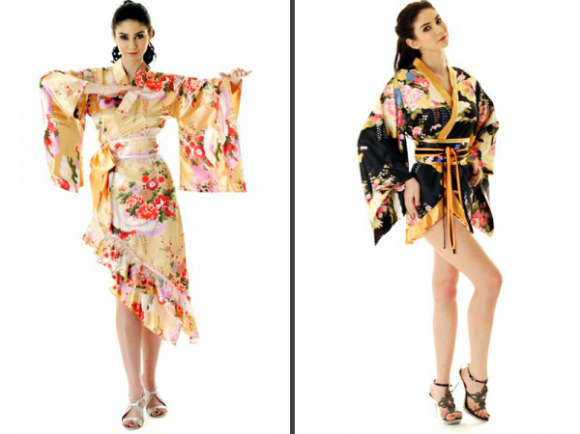
Summer is the season for festivals here in Japan. Every weekend some district or other is putting together a party for locals and tourists to come and enjoy. There are food stands, game stalls, temporary toy shops, and people all around. Most come with a parade event of sorts and end with an explosion of amazing fireworks. But above all, something you’re always going to find at any self-respecting festival are people dressed traditionally in lightweight yukata (a summer kimono) and jinbei (robe-style shirt and shorts) as they wander the streets.
But what about in Western counties like America? In early September of every year, Saint Louis, Missouri, holds a large Japanese-style festival in the city’s botanical gardens. Despite the lingering heat of late summer, somewhere between 20 to 30 thousand people attend this great cultural event each year. But what do they wear? Judging by the array of kimono and yukata available at the English shopping site A Fashion, people hoping to model some Japanese styles might find themselves in what resembles a crazy costume more than actual clothes.
Here in Japan, it is perfectly common for men and women to go about their daily lives wearing what we now consider traditional Japanese clothing. One can often find women dressed in full kimono sitting between suited businessmen on the trains. Girls might wear yukata to attract attention at a summer concert, and men might wear jinbei when lounging around the house. Just because these things are traditional does not mean they are outdated, and you would be hard-pressed to find a Japanese person who is unfamiliar with the style and fit of such clothing.
Most Westerners, however, do not share that easy familiarity with Japanese styles. Why, you could paint some bamboo on a bath robe, call it a kimono, and many of my fellow Americans would be none the wiser. Sure, that might sound a bit harsh, but let’s look at some of the fundamental differences between what Japanese people call a kimono and what’s being marketed to Westerners under the same name.
▼ The picture on the left comes from A Fashion, and the one on the right from Japanese shopping site Kimono Ichiba.
At first glance, these two pieces might seem quite similar, but fundamentally speaking, they are entirely different. Look closely at the waist, and you’ll see it. The Westernized green kimono is cinched at the waist and accentuates the woman’s curves. This is the exact opposite of traditional Japanese aesthetics, which focus on simplistic forms. Traditional kimono are meant to flatten out all of the planes of a woman’s body and to create a clean, cylindrical form.
This difference in aesthetics can also be seen in the choice of fabrics. The green kimono is very bright and features a loud pattern of starkly contrasting colors and very little cultural significance to the symbols. Traditional Japanese kimono, like the blue one here above, tend to favor paler colors and more subtle patterns. Then there is the matter of fabric. Fine kimono are usually made of 100-percent silk. Yukata, their summer counterparts, are generally made of cotton. However, the distinct shine on the kimono marketed to Westerners would suggest that they’re made of some sort of synthetic fiber, like polyester.
Of course, this does not mean that some clothing manufacturers in Japan haven’t modernized the kimono and given it a bit of extra flair. Many of the yukata sold to young women now have lace around the collar, and in certain specialty stores, one can find so-called kimono in the style of frilly Lolita dresses. However, there is a distinct difference between adjusting traditional styles to reflect modern aesthetics and just plain misinterpreting of the source. So what are we seeing here? Is this a case of Western ignorance or an intentional revision of Japanese garb? These examples should help you be a better judge.
▼ I’d give these two more credit if they weren’t inviting such bad luck upon themselves. Folding the right side of a kimono over top of the left is a style reserved only for the dead and the too-drunk-to-notice…
▼ This is my first time seeing a kimono with flared sleeves and layered skirts, though I image the apron variety has a place in some maid cafes.
▼ Now, I can’t help but feel that an asymmetrical hemline is the exact opposite of simplistic forms. And is that a kimono or some kinky lingerie?
Oh well, whatever it takes to stay cool during the summer, I suppose!
Source: Nikkei Trendy (Japanese)
Pictures: A Fashion




 My summer kimono Totoro! Ghibli mascot and Kiki co-star grace beautiful anime yukata【Photos】
My summer kimono Totoro! Ghibli mascot and Kiki co-star grace beautiful anime yukata【Photos】 Kimono to keep, dressing service, unlimited beer, one of Japan’s best views all in one package
Kimono to keep, dressing service, unlimited beer, one of Japan’s best views all in one package See how beautiful a stained-glass window pattern can be as a kimono!
See how beautiful a stained-glass window pattern can be as a kimono! Rumi Rock’s line of edgy yukata is in pop-up shops, just in time for the summer festival season
Rumi Rock’s line of edgy yukata is in pop-up shops, just in time for the summer festival season Does a denim kimono look or feel good? Our kimono neophyte reporter finds out【Photos】
Does a denim kimono look or feel good? Our kimono neophyte reporter finds out【Photos】 McDonald’s new Happy Meals offer up cute and practical Sanrio lifestyle goods
McDonald’s new Happy Meals offer up cute and practical Sanrio lifestyle goods All-you-can-drink Starbucks and amazing views part of Tokyo’s new 170 meter-high sky lounge
All-you-can-drink Starbucks and amazing views part of Tokyo’s new 170 meter-high sky lounge Studio Ghibli glasses cases let anime characters keep an eye on your spectacles
Studio Ghibli glasses cases let anime characters keep an eye on your spectacles Beautiful Sailor Moon manhole cover coasters being given out for free by Tokyo tourist center
Beautiful Sailor Moon manhole cover coasters being given out for free by Tokyo tourist center Kyoto’s 100 Demons yokai monster parade returns!
Kyoto’s 100 Demons yokai monster parade returns! More foreign tourists than ever before in history visited Japan last month
More foreign tourists than ever before in history visited Japan last month Super Nintendo World expansion gets delayed for several months at Universal Studios Japan
Super Nintendo World expansion gets delayed for several months at Universal Studios Japan Real life yandere? Japanese man’s ex-girlfriend sneaks into his home, cooks up something crazy
Real life yandere? Japanese man’s ex-girlfriend sneaks into his home, cooks up something crazy Our reporter takes her 71-year-old mother to a visual kei concert for the first time
Our reporter takes her 71-year-old mother to a visual kei concert for the first time Our Japanese reporter visits Costco in the U.S., finds super American and very Japanese things
Our Japanese reporter visits Costco in the U.S., finds super American and very Japanese things Disney princesses get official manga makeovers for Manga Princess Cafe opening in Tokyo
Disney princesses get official manga makeovers for Manga Princess Cafe opening in Tokyo Starbucks reopens at Shibuya Scramble Crossing with new look and design concept
Starbucks reopens at Shibuya Scramble Crossing with new look and design concept Beautiful new Final Fantasy T-shirt collection on the way from Uniqlo【Photos】
Beautiful new Final Fantasy T-shirt collection on the way from Uniqlo【Photos】 Is the new Shinkansen Train Desk ticket worth it?
Is the new Shinkansen Train Desk ticket worth it? Foreign English teachers in Japan pick their favorite Japanese-language phrases【Survey】
Foreign English teachers in Japan pick their favorite Japanese-language phrases【Survey】 Japanese convenience store packs a whole bento into an onigiri rice ball
Japanese convenience store packs a whole bento into an onigiri rice ball We try out “Chan Ramen”, an underground type of ramen popular in the ramen community
We try out “Chan Ramen”, an underground type of ramen popular in the ramen community Studio Ghibli releases Kiki’s Delivery Service chocolate cake pouches in Japan
Studio Ghibli releases Kiki’s Delivery Service chocolate cake pouches in Japan Japan’s bone-breaking and record-breaking roller coaster is permanently shutting down
Japan’s bone-breaking and record-breaking roller coaster is permanently shutting down New definition of “Japanese whiskey” goes into effect to prevent fakes from fooling overseas buyers
New definition of “Japanese whiskey” goes into effect to prevent fakes from fooling overseas buyers Studio Ghibli unveils Mother’s Day gift set that captures the love in My Neighbour Totoro
Studio Ghibli unveils Mother’s Day gift set that captures the love in My Neighbour Totoro Foreign passenger shoves conductor on one of the last full runs for Japan’s Thunderbird train
Foreign passenger shoves conductor on one of the last full runs for Japan’s Thunderbird train Domino’s Japan now sells…pizza ears?
Domino’s Japan now sells…pizza ears? New Japanese KitKat flavour stars Sanrio characters, including Hello Kitty
New Japanese KitKat flavour stars Sanrio characters, including Hello Kitty Kyoto creates new for-tourist buses to address overtourism with higher prices, faster rides
Kyoto creates new for-tourist buses to address overtourism with higher prices, faster rides Sales of Japan’s most convenient train ticket/shopping payment cards suspended indefinitely
Sales of Japan’s most convenient train ticket/shopping payment cards suspended indefinitely Sold-out Studio Ghibli desktop humidifiers are back so Totoro can help you through the dry season
Sold-out Studio Ghibli desktop humidifiers are back so Totoro can help you through the dry season Japanese government to make first change to romanization spelling rules since the 1950s
Japanese government to make first change to romanization spelling rules since the 1950s Ghibli founders Toshio Suzuki and Hayao Miyazaki contribute to Japanese whisky Totoro label design
Ghibli founders Toshio Suzuki and Hayao Miyazaki contribute to Japanese whisky Totoro label design Doraemon found buried at sea as scene from 1993 anime becomes real life【Photos】
Doraemon found buried at sea as scene from 1993 anime becomes real life【Photos】 Tokyo’s most famous Starbucks is closed
Tokyo’s most famous Starbucks is closed One Piece characters’ nationalities revealed, but fans have mixed opinions
One Piece characters’ nationalities revealed, but fans have mixed opinions We asked a Uniqlo employee what four things we should buy and their suggestions didn’t disappoint
We asked a Uniqlo employee what four things we should buy and their suggestions didn’t disappoint Princesses, fruits, and blacksmiths: Study reveals the 30 most unusual family names in Japan
Princesses, fruits, and blacksmiths: Study reveals the 30 most unusual family names in Japan Kim Kardashian drops plans to call new fashion brand Kimono Solutionwear
Kim Kardashian drops plans to call new fashion brand Kimono Solutionwear Busty or boobless? Japanese Twitter debates which makes for more beautiful kimono anime art
Busty or boobless? Japanese Twitter debates which makes for more beautiful kimono anime art Comfy kimono hakama roomwear steps into the modern era with stylish new Reiwa Edition【Photos】
Comfy kimono hakama roomwear steps into the modern era with stylish new Reiwa Edition【Photos】 Gorgeous acrylic men’s geta are more artwork than they are footwear
Gorgeous acrylic men’s geta are more artwork than they are footwear New magazine focused on modern and casual kimono styles launched this month
New magazine focused on modern and casual kimono styles launched this month Kimono genius turns obi sash into the head of Evangelion Unit-01【Photos】
Kimono genius turns obi sash into the head of Evangelion Unit-01【Photos】 Maybelline and Furifu release a retro-modern “Traditions of Japan” yukata collection
Maybelline and Furifu release a retro-modern “Traditions of Japan” yukata collection New Disney summer kimono are beautifully cute and require no sash tying【Photos】
New Disney summer kimono are beautifully cute and require no sash tying【Photos】 New summer kimono from Felissimo features cats playing with flowers
New summer kimono from Felissimo features cats playing with flowers Beautiful line of Kimono Pouches let you add traditional Japanese style to any outfit
Beautiful line of Kimono Pouches let you add traditional Japanese style to any outfit Kimono rental shops in Kyoto and Nara offer Japanese-style hijabs to buy or rent
Kimono rental shops in Kyoto and Nara offer Japanese-style hijabs to buy or rent Harajuku kimono event aims to usher in the new year in style!
Harajuku kimono event aims to usher in the new year in style! Ariel and Jasmine star in Disney princess pseudo-kimono line from Japanese fashion brand【Photos】
Ariel and Jasmine star in Disney princess pseudo-kimono line from Japanese fashion brand【Photos】 Yukata summer kimono separates allow you to mix and match traditional outfits with everyday wear
Yukata summer kimono separates allow you to mix and match traditional outfits with everyday wear Kimono dress shirt is a sleek reimagining of Japan’s most feminine type of traditional clothing
Kimono dress shirt is a sleek reimagining of Japan’s most feminine type of traditional clothing
Leave a Reply